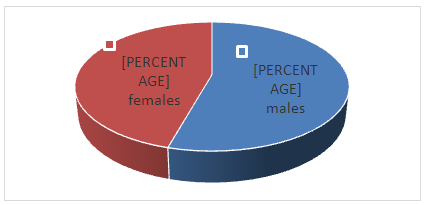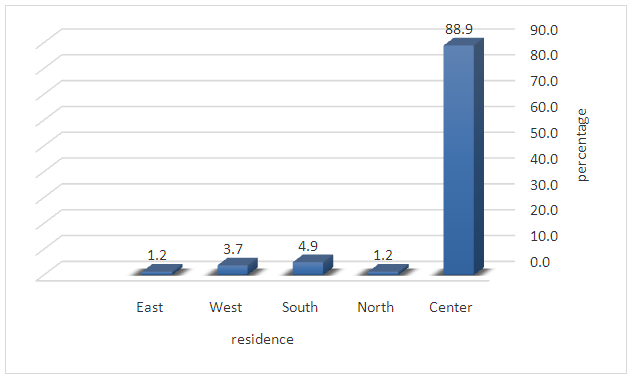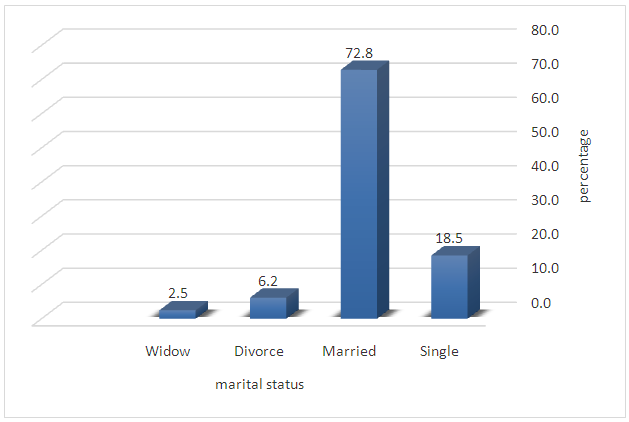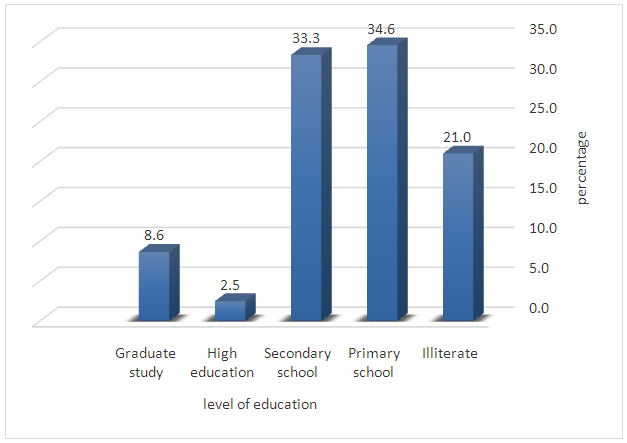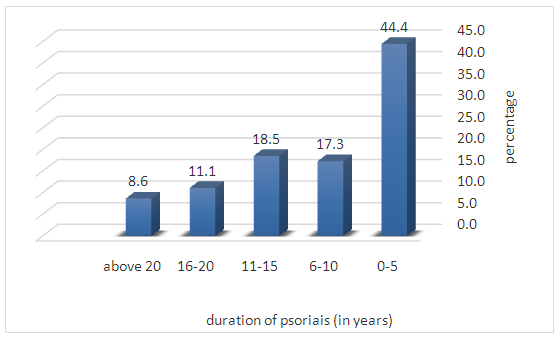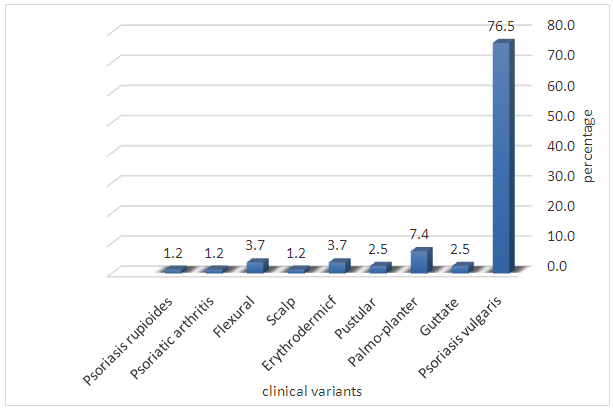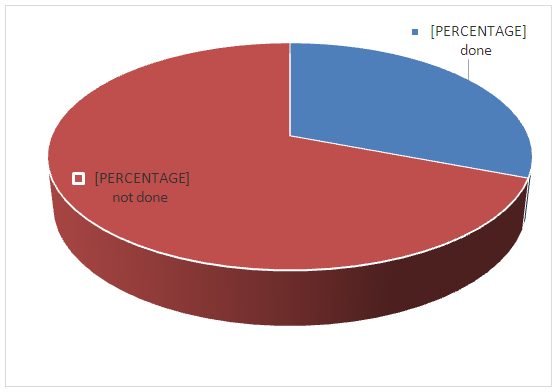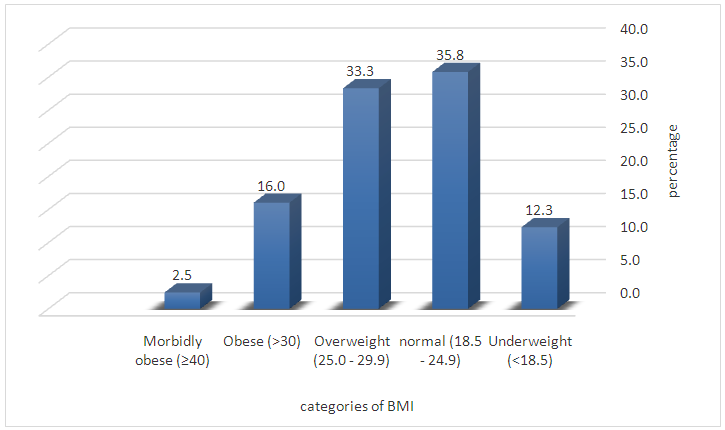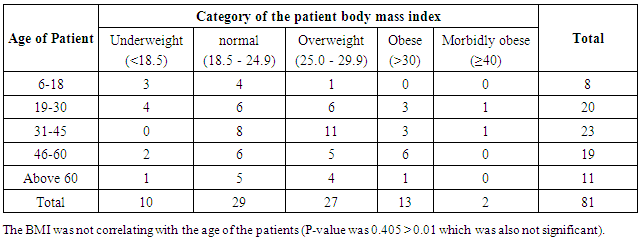-
Paper Information
- Paper Submission
-
Journal Information
- About This Journal
- Editorial Board
- Current Issue
- Archive
- Author Guidelines
- Contact Us
American Journal of Dermatology and Venereology
p-ISSN: 2332-8479 e-ISSN: 2332-8487
2017; 6(2): 30-39
doi:10.5923/j.ajdv.20170602.03

Correlation between the Body Mass Index and Psoriasis in Dermatology and Venereology Teaching Hospital in Khartoum
Huda Eltigani Elobeid 1, Khalid O. Alfarouk 2, Ahmed N. Aljarbou 3, Gamal O. Elhassan 4, A. K. Muddathir 5, Abdel Rahman M. A. Ramadan 6, Adil H. H. Bashir 2
1Khartoum Dermatology Teaching Hospital, Khartoum, Sudan
2Institute of Endemic Diseases, University of Khartoum, Sudan
3College of Pharmacy, Qassim University, Buraydah, KSA
4Omdurman Islamic University, Khartoum, Sudan
5Faculty of Pharmacy, University of Khartoum, Khartoum, Sudan
6College of Dentistry, Taibah University, Al-Madinah Al-Munawarah, KSA
Correspondence to: Adil H. H. Bashir , Institute of Endemic Diseases, University of Khartoum, Sudan.
| Email: |  |
Copyright © 2017 Scientific & Academic Publishing. All Rights Reserved.
This work is licensed under the Creative Commons Attribution International License (CC BY).
http://creativecommons.org/licenses/by/4.0/

Background: Psoriasis is a common, chronic, disfiguring, noninfectious inflammatory and proliferative condition of the skin, in which both genetic and environmental influences have a critical role. Body Mass Index (BMI) is a simple index of weight for height that is commonly used to classify underweight, overweight and obesity. Several studies suggested a significant correlation between psoriasis and high BMI which may affect adversely the course and the treatment of the disease. Objectives: The study aimed to determine the correlation between psoriasis and BMI and to determine the epidemiological characteristics of psoriasis in Sudanese patients involved in the study. Methodology: This study was a prospective, observational descriptive hospital-based cross-sectional study, conducted in Dermatology and Venereology Teaching Hospital in Khartoum in the period from August to November 2015, it included 81 psoriatic patients; Questionnaires were filled regarding the patients demographic and medical data of their disease. The weight and height of every patient were measured, and then the body mass indices were calculated and categorized. The data were then analyzed by using statistical package for social science (SPSS). Results: 44 males represented (54.3%) and 37 females (45.7%) their ages were between 18 and > 60 years. 72 patients (88.9%) did not have a family history of psoriasis while nine patients (11.1%) had a positive history. Psoriasis vulgaris was the most presented clinical variant (76.5%). The most significant finding in this study is that 33.3% of the patients involved were overweight (BMI 25-29.9), 16% were obese (BMI >30) and 2.5% were morbidly obese patients (BMI ≥ 40), the total percentage of them represented 51.8% of the total number of patients. The mean BMI was found to be 25.34. Conclusions: In this study, the body mass indices of more than half of the patients (51.8%) were found higher than the normal. The mean BMI was high (25.34). That may extend the previous reports of the association of psoriasis and the high BMI. Most of the psoriatic patients with high BMI were females (54% of the patients with high BMI). There was no correlation between the BMI and the age of the patient neither with the duration of the disease.
Keywords: Body Mass Index, BMI, Psoriasis, Sudan
Cite this paper: Huda Eltigani Elobeid , Khalid O. Alfarouk , Ahmed N. Aljarbou , Gamal O. Elhassan , A. K. Muddathir , Abdel Rahman M. A. Ramadan , Adil H. H. Bashir , Correlation between the Body Mass Index and Psoriasis in Dermatology and Venereology Teaching Hospital in Khartoum, American Journal of Dermatology and Venereology, Vol. 6 No. 2, 2017, pp. 30-39. doi: 10.5923/j.ajdv.20170602.03.
1. Introduction
- Psoriasis is a common, chronic, disfiguring, noninfectious inflammatory and proliferative condition of the skin, in which both genetic and environmental influences have a critical role. The most characteristic lesions consist of red, scaly, sharply demarcated, indurated plaques present particularly over extensor surfaces and scalp. The disease is enormously variable in duration, the periodicity of flares and extent. Morphological variants are common. Psoriasis affects 2–4% of the population. It can start at any age including childhood, with peaks of onset at 15–25 years and 50–60 years. It tends to persist lifelong, fluctuating in extent and severity. It is particularly common in Caucasians but may affect people of any race. About one-third of patients have family members with psoriasis [1].Body Mass Index (BMI) is a simple index of weight for height that is commonly used to classify underweight, overweight, and obesity. It is defined as the weight in kilograms divided by the square of the height in meters (kg/m2) [2].Correlation of psoriasis with high BMI has been found to be associated with an increased risk of psoriasis in general population, and psoriasis patients have higher prevalence and incidence of high BMI [3, 4].High BMI manifested as overweight and obesity has different risk effect on severity and manifestations of psoriasis and might be useful for better evaluating psoriasis clinically [5].One study suggested that obesity at an early age increases the risk of developing Psoriatic Arthropathy (PsA). Adiposity is associated with higher levels of inflammatory cytokines known to be associated with psoriasis. Prevention and early treatment of obesity may decrease the risk of PsA [6].Also, in psoriasis patients, high BMI is associated with a more severe disease, especially in men. Bodyweight control may be necessary for the management of psoriasis [7].It is found that body weight reduction in obese psoriatic patients on biologics may increase the efficacy of the drugs [8].RationaleThe calculation of the body mass index (BMI) of patients who have psoriasis is necessary, most of the studies concluded that there is a higher prevalence of high BMI among psoriatic patients compared with the general population, which worsen the course of the disease and delay the response to treatment; as well as no similar studies had been made in Sudan.
2. Objectives
- General ObjectiveTo determine the correlation between the body mass index (BMI) and psoriasis in patients who attended Dermatology and Venereology Teaching Hospital in Khartoum during the period from August to November 2015.Specific Objectives1- To determine the correlation between the body mass index and psoriasis in patients attended Khartoum Dermatology and Venereology Teaching Hospital during the period from August to November 2015.2- To detect the demographic characteristics of psoriasis among this study group.3- To determine the prevalence of different clinical variants of psoriasis in this study group.Patients and MethodsThis was a prospective, observational descriptive hospital-based cross-sectional study.B- Study area:Khartoum Skin and Venereal diseases Teaching Hospital were considered as the study area. The hospital is considered the first specialized hospital in Dermatology and Venereology in Sudan, serving about 200-400 patients every day. Those patients are from Khartoum state and the other states of Sudan.The hospital is serving the patients 24 hours per day, every day with regular clinics during the daytime (9:00 am – 3:00 pm) and emergency clinics at the rest of the day and during the night.Those clinics involve general and specialized clinics:The general clinics are:1- The outpatient's clinics for the new cases2- The referred clinics, to follow the old cases.The specialized clinics are:1- Psoriasis Clinic, once a week serving psoriasis patients.2- Leprosy clinic once a week.3- Venereal diseases and Andrology Clinic, twice a week.The hospital has several general wards to serve the in patients (one for the children, other for men and third for women); also, there is a private section.Other hospital facilities:Laboratory services: serving the outpatients and the in patients.-- Phototherapy section.- Pharmacy.- Minor Theater for the minor operations is available.- Teaching section, including library and lecture theatersc- Study period:The study had been conducted during the period from August to November 2015.d- Study population:All patients are known as Psoriatic cases who attended Skin and Venereal diseases Teaching Hospital in Khartoum during the study period and who met the inclusion criteria were considered in the study.- Inclusion criteria:All Sudanese patients agreed to share the study, with any of psoriasis variants who attended the Skin and Venereal diseases Teaching Hospital in Khartoum during the study period.- The exclusion criteria:The patients with one or more of the following criteria were excluded:1- NonSudanese2- Patients refused to participate in the studye- Sample size and sampling techniques:It was a probability sampling.81 patients had been included in the study.F- Data collection:Eighty-one patient is is known to have psoriasis and who met the inclusion criteria were included in the study. The diagnosis of psoriasis in every case was confirmed by a consultant dermatologist based on the clinical findings (history and clinical examination), and when indicated (in some doubtful cases) the clinical diagnosis has been supported and confirmed by doing histopathology of skin biopsy.Then, data were collected from the included patients and were written down in the pre-tested structured questionnaire. The questionnaires were filled by the researcher herself, and data collected from the participated patients regarding their demographic data and some information regarding their psoriasis.Then the length and weight of the patients were measured by using a measuring tape and weighing scale respectively.After that, the body mass indices of the participated patients were calculated.Calculation of the body masses indexBMI is calculated the same way for both adults and children. The calculation is based on the following formulas [9]:
 In this study, the body mass indices were calculated by using the first formula. The calculated body mass indices were then categorized into five groups (according to WHO classification of the BMI) [10]:Classification of the body mass index:
In this study, the body mass indices were calculated by using the first formula. The calculated body mass indices were then categorized into five groups (according to WHO classification of the BMI) [10]:Classification of the body mass index: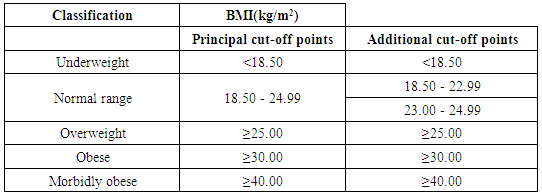 G- Data analysis:The collected data were analyzed by using Statistical Package for Social Science (SPSS). Descriptive analysis was done for all the questionnaire parameters.H- Ethical consideration:This study has been presented to the ethical review committee of Sudan Medical Specialization Board (SMSB), Council of dermatology. Permission had been granted from authorities of health care in the study area. Verbal and written consent was taken from every participant.
G- Data analysis:The collected data were analyzed by using Statistical Package for Social Science (SPSS). Descriptive analysis was done for all the questionnaire parameters.H- Ethical consideration:This study has been presented to the ethical review committee of Sudan Medical Specialization Board (SMSB), Council of dermatology. Permission had been granted from authorities of health care in the study area. Verbal and written consent was taken from every participant.3. Results
- This study included 81 patients, 44 of them were males (54.3%), and the remaining 37 patients were females (45.7%), (figure 1). The male to female ratio was 1.19 to 1.
|
|
|
4. Discussion
- In this study 81 patients included, males represented 54.3%, and the remaining 45.7% were females. Male to female ratio was 1.19 to 1 with more prevalence of psoriasis among males. These results were approximately similar to the result of other study concluded that over half of the psoriasis population (54.7%) were males (Kimball AB et al., 2014) [11]. Also, another cross-sectional study (Islam MT et al, 2011) conducted on 102 cases having clinical manifestation of psoriasis to (or “intending to”) evaluating the epidemiological determinants of psoriasis concluded that 68.6% patients were males and 31.4% were females with a male to female ratio of 2.18:1 [11].Most of the cases fell between 19 and 45 years. The mean age was found to be 41.43 years, which is lower than a mean age of 48.6 years calculated in patients enrolled in the Psoriasis Longitudinal Assessment and Registry (PSOLAR) to evaluate demographic and disease characteristics of psoriasis (Kimball AB et al., 2014) [12].Only 11.1%, (9) patients had positive family history of psoriasis, a percentage close to 15.7% of positive history concluded in a similar study (Islam MT et al, 2011) [12], while an epidemiological study in Greece to determine characteristics of psoriasis found that 35% of patients reported a positive family history of psoriasis(Rigopoulos D et al., 2010) [13].The most common clinical variant of psoriasis was Psoriasis vulgaris (76.5%) followed by palmoplantar psoriasis (7.4%). Erythrodermic psoriasis and flexural psoriasis represented (3.7%) for each of them. Guttate and Pustular Psoriasis represented (2.5%) for each of them. These results were slightly different from those of cross-sectional study among 296 Malaysian patients with psoriasis, showed that the most common clinical presentation was chronic plaque psoriasis (89.9%), followed by erythrodermic psoriasis (4.7%), Guttate Psoriasis (3.0%) and Pustular Psoriasis (1.7%) (Loo CH et al., 2015) [14].The most significant finding in this study is that 33.3% of the patients (27 patients) involved were overweight (BMI 25-29.9), 16% (13 patients) were obese (BMI >30) and 2.5% (2 patients) were morbidly obese patients (BMI ≥ 40). The total percentage of them represented 51.8% of the total number of patients, represented almost more than the half of the patients, a high percentage, and that might extends previous reports of an association between psoriasis and high BMI, (Duarte GV et al., 2013) [15].To evaluate the occurrence of obesity and dyslipidemia in patients with psoriasis in Manaus (in northern Brazil); a study included 72 patients was done, 16 (22.2%) were overweight, and 20 (27.8%) were obese (Santos M et al., 2013) [16].The mean BMI was found to be 25.34 compared to a BMI of 28.0 calculated in a German study (Jacobi A et al., 2015) aimed to assess the prevalence of obesity in patients with psoriasis in Germany; that study concluded that the prevalence of obesity in patients with psoriasis is higher than in the normal population and also showed that the trend towards a higher BMI in patients with psoriasis continues over time [17].Most of the males BMIs were either normal: 23.46% (19 patients) or overweight 20.99% (17 patients). On the other hand, most of the female BMIs were higher than normal; overweight were 10 females (12.35%), obese were 11 (13.58%), and two females (2.47%) were morbidly obese, this showed that in this study most of the psoriatic patients with high BMI were females (54% of the total patients with high BMI).Moreover, body mass index, irrespective of adjustment for diabetes mellitus, age, skin Phototype, gender, family history of diabetes mellitus or hip/waist ratio. Qualitatively elevated HOMA-IR levels (>3.8) were also significantly associated.
5. Conclusions
- In this study, the body mass indices (BMI) of more than half of the patients (51.8%) were found higher than the normal. The mean BMI was high (25.34). However, there was a negative correlation between the BMI and age of patients and also a negative correlation between the BMI and the duration of the disease. In this study, most of the psoriatic patients with high BMI were females (54% of the total no. of patients with high BMIs). This study also provided epidemiological information regarding psoriasis in Sudanese patients:- Most of the patients were between 19-45 years old (53.1%). The mean age was found to be 41.43 years.- Prevalence of psoriasis was found more among males (54.3%). Male to female ratio was 1.9:1.- Most of the patients had no family history of psoriasis (88.9%).- Psoriasis vulgaris was the commonest clinical variant (76.5%), followed by Palmo-planter psoriasis (7.4%).
6. Recommendations
- 1. Further studies among larger groups of psoriatic patients in Sudan to determine the correlation between psoriasis severity and BMI and to identify how the BMI (especially the high BMI) may affect psoriasis course and treatment.2. Advising the overweight and obese patients to normalize their BMI to achieve better control of psoriasis (depending on previous studies and reports).
References
| [1] | Burns DA, Breathnach SM, CoxNH, Griffiths CEM. Rook’s Textbook of Dermatology, 7 thed. USA: Blackwell Science; 2004: page 35.1. |
| [2] | WHO contributors. BMI classification. (Accessed 27 August 2015). |
| [3] | McGowan JW, Pearce DJ, Chen J, Richmond D, Balkrishnan R, Feldman SR. The Skinny on Psoriasis and Obesity. Arch Dermatol. 2005; 141(12): 1601-1602. |
| [4] | Duarte GV, Oliveira M d., Cardoso T M., Follador I, Silva TS., Cavalheiro CM. Nonato W, Carvalho EM. Association between obesity measured by different parameters and severity of psoriasis. International Journal of Dermatology, 52: 177–181. |
| [5] | Zhang, Zhu KJ, Zheng HF, Cui Y, Zhou FS, Chen YL, et al. The effect of overweight and obesity on psoriasis patients in Chinese Han population: a hospital-based study. J Eur Acad Dermatol Venereol.2011 Jan; 25(1): 87-91. |
| [6] | Soltani-Arabshahi R, Wong B, Feng BJ, Goldgar DE, Duffin KC, Krueger GG. Obesity in early adulthood as a risk factor for psoriatic arthritis. Arch Dermatol.2010 Jul; 146(7): 721-6. |
| [7] | Huang Y, Yang LC, Hui RY, Chang YC, Yang YW, Yang CH, Chen YH, Chung, WH, Kuan YZ. Chiu CS. Relationships between obesity and the clinical severity of psoriasis in Taiwan. Journal of the European Academy of Dermatology and Venereology, 24: (1)1035–1039. |
| [8] | Al-Mutairi N, Nour T. The effect of weight reduction on treatment outcomes in obese patients with psoriasis on biologic therapy: a randomized controlled prospective trial. Expert Opin Biol Ther. 2014 Jun; 14(6):749-56. |
| [9] | CDC contributers. About Adult BMI. http://www.cdc.gov/healthyweight/assessing/bmi/adult_bmi/ (accessed 27 August 2015). |
| [10] | WHO contributers. BMI classification. http://apps.who.int/bmi/index (accessed 27 August 2015). |
| [11] | Kimball AB, Leonardi C, Stahle M, Gulliver W, Chevrier M, Fakharzadeh S, et al. Demography, baseline disease characteristics and treatment history of patients with psoriasis enrolled in a multicentre, prospective, disease-based registry (PSOLAR). Br J Dermatol 2014 Jul; 171(1):137-47. |
| [12] | Islam MT, Paul HK, Zakaria SM, Islam MM, Shafiquzzaman M. Epidemiological determinants of psoriasis. Mymensingh Med J January 2011; 20(1): 9-15. |
| [13] | Kimball AB, Leonardi C, Stahle M, Gulliver W, Chevrier M, Fakharzadeh S, et al. Demography, baseline disease characteristics and treatment history of patients with psoriasis enrolled in a multicentre, prospective, disease-based registry (PSOLAR). Br J Dermatol 2014 Jul; 171(1): 137-47. |
| [14] | Islam MT, Paul HK, Zakaria SM, Islam MM, Shafiquzzaman M. Epidemiological determinants of psoriasis. Mymensingh Med J January 2011; 20(1): 9-15. |
| [15] | Rigopoulos D, Gregoriou S, Katrinaki A, Korfitis C, Larios G, Stamou C, Mourellou O, et al. Characteristics of psoriasis in Greece: an epidemiological study of a population in a sunny Mediterraneanclimate. Eur J Dermatol. 2010 Mar-Apr; 20(2): 189-95. |
| [16] | Loo CH, Chan YC, Lee KQ, Tharmalingam P, Tan WC. Clinical profile, morbidity and outcome of adult patients with psoriasis at a district hospital in Northern Malaysia. Med J Malaysia 2015 Jun; 70(3): 177-81. |
| [17] | Duarte GV, Oliveira Mde F, Cardoso TM, Follador I, Silva TS, Cavalheiro CM, et al. Association between obesity measured by different parameters and severity of psoriasis. Int J Dermatol. 2013 Feb; 52(2): 177-81. |
| [18] | Santos M, Fonseca HM, Jalkh AP, Gomes GP, Cavalcante Ade S. Obesity and dyslipidemia in patients with psoriasis treated at a dermatologic clinic in Manaus. An Bras Dermatol. 2013 Nov-Dec; 88(6): 913-6. |
| [19] | Jacobi A, Langenbruch A, Purwins S, Augustin M, Radtke MA. Prevalence of Obesity in Patients with Psoriasis: Results of the National Study PsoHealth3.Dermatology. 2015; 231(3): 231-8. |
 Abstract
Abstract Reference
Reference Full-Text PDF
Full-Text PDF Full-text HTML
Full-text HTML